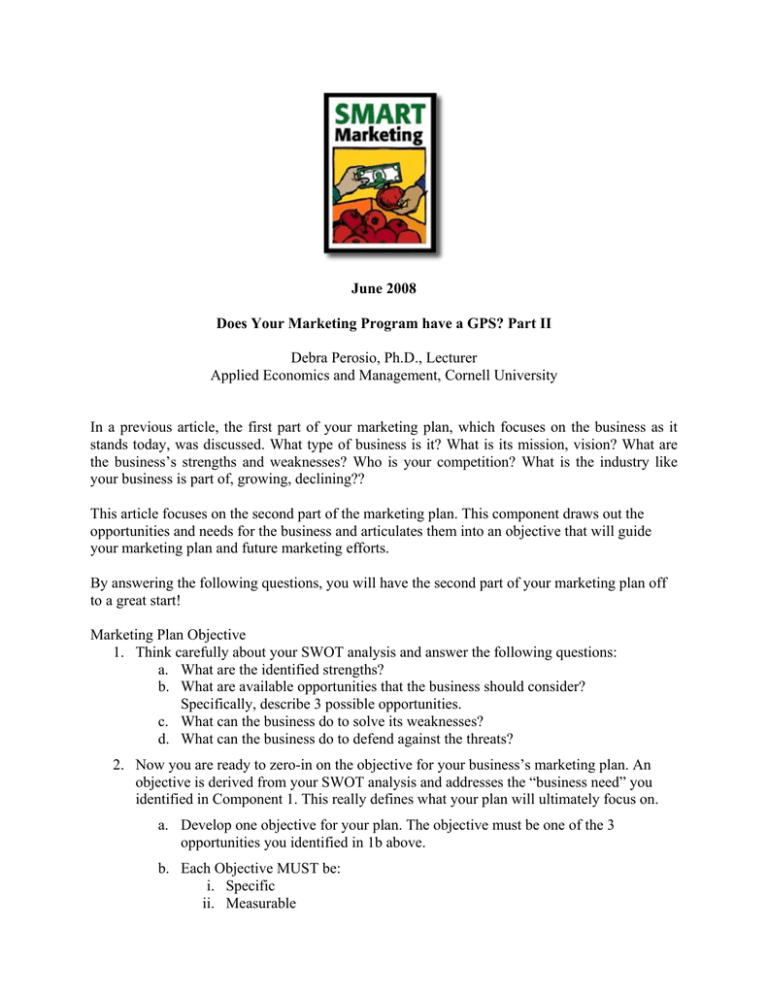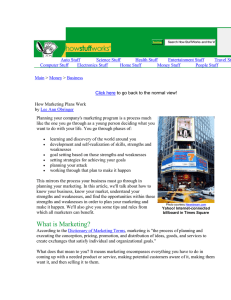Debra Perosio, Ph.D., Lecturer Applied Economics and Management, Cornell University
advertisement

June 2008 Does Your Marketing Program have a GPS? Part II Debra Perosio, Ph.D., Lecturer Applied Economics and Management, Cornell University In a previous article, the first part of your marketing plan, which focuses on the business as it stands today, was discussed. What type of business is it? What is its mission, vision? What are the business’s strengths and weaknesses? Who is your competition? What is the industry like your business is part of, growing, declining?? This article focuses on the second part of the marketing plan. This component draws out the opportunities and needs for the business and articulates them into an objective that will guide your marketing plan and future marketing efforts. By answering the following questions, you will have the second part of your marketing plan off to a great start! Marketing Plan Objective 1. Think carefully about your SWOT analysis and answer the following questions: a. What are the identified strengths? b. What are available opportunities that the business should consider? Specifically, describe 3 possible opportunities. c. What can the business do to solve its weaknesses? d. What can the business do to defend against the threats? 2. Now you are ready to zero-in on the objective for your business’s marketing plan. An objective is derived from your SWOT analysis and addresses the “business need” you identified in Component 1. This really defines what your plan will ultimately focus on. a. Develop one objective for your plan. The objective must be one of the 3 opportunities you identified in 1b above. b. Each Objective MUST be: i. Specific ii. Measurable iii. Implementable and realistic (i.e., feasible for the particular business) iv. Specify a time frame. Below are examples of objectives…yours should be in this format! Increase the purchases of jams and jellies at my farm stand by 20% during 2009 by developing 3 new flavors, new signage at the market and through advertisements in the local weekly newspaper. Increase customers to my corn maze during the fall of 2008 by 25% by increased advertising, development of group rates and three special theme nights at the maze. c. How will you assess and measure your success/failure in achieving your objective? Survey? Focus groups? Changes in gross receipts? Other? While there are many ways to evaluate the success/failure of a marketing objective, typically a survey is a critical evaluation method. The survey can be administered by telephone, in person, by mail or via the internet. For a survey, think about the following: i. ii. iii. iv. who and how many will be surveyed the specific data to be collected (Provide several sample questions) how the data will be collected (e.g. mall intercept, phone survey, etc.) how the data will be analyzed (i.e. manually or by computer) specifically how the data will be used as a measure of success 3. Target Market(s) In the objective you just developed you have identified a target market or markets. Now you have to describe this market in detail. If is it the same target market you described in Component 1 you can simply refer to the previous section in your marketing plan for a complete description. By getting to know this target market really well you will be much better prepared to more accurately predict the types of advertising and promotions that will most likely appeal to them. 4. Points of Difference What currently distinguishes the business in the marketplace? What makes you different? Through the development of your objective, will there be a new or additional point of difference? Why or why not? (there should be points of difference…that is why you are doing a marketing plan!) Next time I will discuss the last part of your marketing plan. This will focus on developing this new objective fully and creating and advertising and promotional campaign to help “spread the word” to your target market. “Smart Marketing” is a marketing newsletter for extension publication in local newsletters and for placement in local media. It reviews elements critical to successful marketing in the food and agricultural industry. Please cite or acknowledge when using this material.







